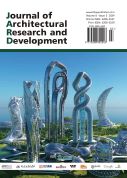“Chineseness”: A Discussion on Cases Related to Tulou in Contemporary Chinese Architecture
Abstract
The article delves into the concept of “Chineseness” in contemporary Chinese architecture, a strategic tool for creating distinctive styles rooted in Chinese identity. It serves not only to distinguish projects from market-driven trends but also to establish a pivotal position in the global architectural landscape. "Chineseness" among 24 identified keywords represents a practical strategy embraced by many young architects with international exposure. The traditional Chinese dwelling, a symbol of familial and cultural essence, particularly in the context of home culture, is a primary inspiration for contemporary architects. The research adopts a case study approach, focusing on Tulou-related cases from the last fifteen years, encompassing various building types. The Tulou, a mountain-dwelling with rich cultural connotations, is introduced, reflecting ancient Chinese philosophies in its architectural principles. The case studies, including URBANUS’s “Tulou Collective Housing 2008" and Chengdu’s “Tulou Theater,” demonstrate how Tulou prototypes can be creatively adapted. These designs not only replicate forms but also capture the communal spirit inherent in traditional dwellings. “Stepped Courtyards” by OPEN Architecture reinterprets Tulou typology for a staff dormitory, emphasizing community awareness. In conclusion, the concept of “Chineseness” emerges as a prominent topic, showcasing the dynamic and adaptable nature of traditional Chinese culture and modern architectural expressions. The cases illustrate the evolving intersection between traditional Chinese culture and modern architecture, offering insights into the future trajectory of Chinese architectural culture. The interrelated keywords highlight the nuanced and evolving nature of “Chineseness” in architectural practices.
References
Li X, Ni M, 2011, 24 Keywords Mapping the Conditions, Discourses, and Strategies of Contemporary Young Chinese Architects. Time + Architecture, 2011(02): 30–35.
Li X, Mo W, Wang X, 2024, Theorizing a New Agenda for Contemporary Chinese Architecture. Architectural Journal, 2024(01): 6–13.
Crysler CG, Cairns S, Heynen H, (eds) 2012, The SAGE Handbook of Architectural Theory, SAGE, Los Angeles, v–viii.
Liu X, Meng Y, 2008, Tulou Collective Housing, Guangdong, China. World Architecture, 2015(03): 64.
Cai M, 2008, Exploration of Off-site Development of Intangible Cultural Heritage under the Perspective of Authenticity: Taking Chengdu Intangible Cultural Heritage National Park as an Example. Business & Economy, 2008(12): 90–92.
Li H, Huang W, 2015, Stepped Courtyards. Architectural Journal, 2015(5): 50–56.
Wang M-Y, 2010, The Historicization of Chinese Architecture: The Making of Architectural Historiography in China, from the Late Nineteenth Century to 1953, dissertation, Columbia University, 2010: 16–23.

